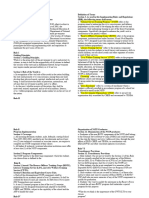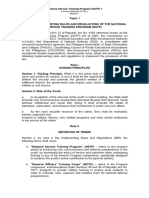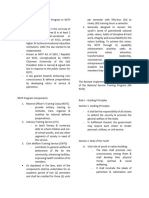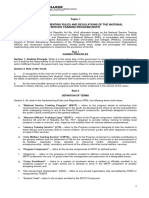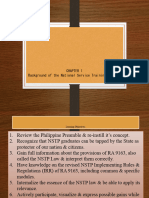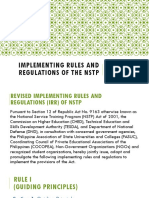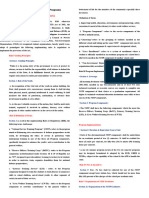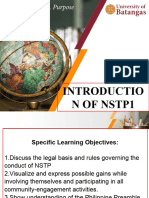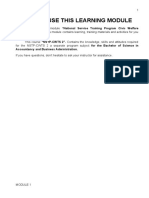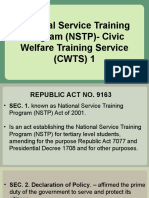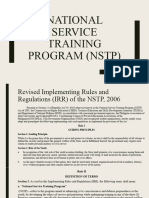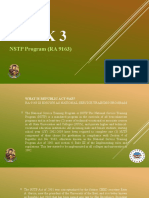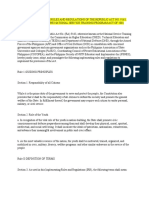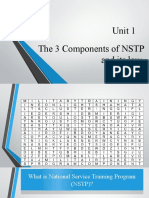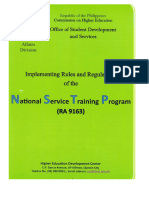0 ratings0% found this document useful (0 votes)
48 views102 pagesNSTP2
Uploaded by
Kc FlorendoCopyright
© © All Rights Reserved
We take content rights seriously. If you suspect this is your content, claim it here.
Available Formats
Download as PDF or read online on Scribd
0 ratings0% found this document useful (0 votes)
48 views102 pagesNSTP2
Uploaded by
Kc FlorendoCopyright
© © All Rights Reserved
We take content rights seriously. If you suspect this is your content, claim it here.
Available Formats
Download as PDF or read online on Scribd
You are on page 1/ 102
NSTP
National Training
Service Program
MODULE 2
MODULE 1A:
“INTRODUCTION”
¢ LEARNING OBJECTIVES:
e At the end of the module, students
will be able to:
* 1. Discuss the implementing rules
& regulations of the course.
¢ 2. Be acquainted w/ their
instructors & classmates.
CWTS ROTC
IMPLEMENTING RULES & REGULATIONS
Pursuant to Section 12 of Republic Act No. 9163 otherwise known as
the National Service Training Program (NSTP) Act of 2001, the Commission of
Higher Education (CHED), Technical Education & Skills Development Authority
(TESDA), & Department of National Defense (DND), in consultation with
concerned government agencies, the Philippine Association of State
Universities & Colleges (PASUC), Coordinating Council of Private Educational
Associations of the Philippines (COCOPEA), Non-Government Organizations
(NGOs) & recognized student organizations, hereby jointly issue, adopt &
promulgate the following implementing rules & regulations to implement the
provisions of the Act.
Rule
Guiding Principles
Section 1. Guiding Principles. While it is the prime duty of the
government to serve & protect its citizens, in turn it shall be
the responsibility of all citizens to defend the security of the
State, & in fulfillment thereof, the government may require
each citizen to render personal military or civil service.
Section 2. Role of the Youth.
a. In recognition of the vital role of the youth in nation building, the
State shall promote civic consciousness among them & shall
develop their physical, moral, spiritual, intellectual & social well
being. It shall inculcate the ideals of patriotism, nationalism, &
advance their involvement in public & civic affairs.
b. As the most valuable resource of the nation, they shall be
motivated, trained, organized & involved in military, literacy, civic
welfare programs & other similar endeavors in the service of the
nation.
Rule It
Definition of Terms
Section 3 As used in this implementing Rules & Regulations (IRR), the following
terms shall mean:
a. “National Service Training Program’ (NSTP)- refers to the program aimed at
Enhancing civic consciousness & defense preparedness in the youth, by
developing the ethics of service & patriotism while undergoing training in any of
the three (3) Program components, specifically designed to enhance the
youth's active contribution to the general welfare;
b. “Reserve Officers Training Corps” (ROTC)- refers to the Program component,
institutionalized under Sections 38 & 39 of Republic Act no. 7077, designed to
provide military training to tertiary level students in order t motivate, train,
organize &mobilize them for national defense preparedness:
¢. ‘Literacy Training Service” (LTS)- refers to the Program component designed to
train the students to teach literacy & numeracy skills to school children, out-of-
school youths & other segments of society in need of their services;
4. “Civic Welfare Training Service” (CWTS) - refers to the Program component or
activities contributory to the general welfare & betterment of life for the members of
the community or the enhancement of its facilities, especially those devoted to
Rule I
Definition of Terms
Section 3. As used in this implementing Rules & Regulations
(IRR), the following terms shall mean:
a. “National Service Training Program” (NSTP)- refers to the
program aimed at Enhancing civic consciousness & defense
preparedness in the youth, by developing the ethics of service
& patriotism while undergoing training in any of the three (3)
Program components, specifically designed to enhance the
youth's active contribution to the general welfare;
b. “Reserve Officers Training Corps” (ROTC)- refers to the
Program component, institutionalized under Sections 38 & 39
of Republic Act no. 7077, designed to provide military training
to tertiary level students in order t motivate, train, organize
&mobilize them for national defense preparedness.
Definition of Terms
c. “Literacy Training Service” (LTS)- refers to the Program
component designed to train the students to teach literacy
& numeracy skills to school children, out-of-school youths &
other segments of society in need of their services;
d. “Civic Welfare Training Service” (CWTS) - refers to the
Program component or activities contributory to the general
welfare & betterment of life for the members of the
community or the enhancement of its facilities, especially
those devoted to
Definition of Terms
e. Improving health, education, environment,
entrepreneurship, safety, recreation & moral of the citizenry
& other social welfare services;
f. “Program Component’- refers to the service components
of the NSTP as defined herein;
g. “Clustering”- refers to the grouping of students enrolled
in the different schools & taking up the same NSTP
component into one (1) group under the management &
supervision of a designated school;
Definition of Terms
h. “Cross Enrollment’- refers to a system of enrollment
where a student is officially enrolled in an academic
program of a school but is allowed to enroll in the NSTP
component of another school; and
i. “Non-Government Organization” (NGO)- refers to any
private organization duly accredited by CHED or
recognized by TESDA.
Rule Ill
Program Implementation
Section 4. Coverage:
All tneaming freshmen students, male & female, starting
School Year (SY) 2002-2003, enrolled in any baccalaureate &
in at least two (2) year technical-vocational or associate
courses, are require to complete one (1) NSTP component of
their choice, as a graduation requirement. All higher &
technical-vocational education institutions must offer at least
one (1) of the NSTP components.
Section 5: Program Components:
The NSTP shall have the following components which the
students can choose from as defined in Rule II, Section 3
hereof: The Reserve Officers Training Corps (ROTC), Literacy
aug Service (LTS), & Civic Welfare Training Service
Program
Implementation
Section 6: Duration & Equivalent Course Unit:
Each of the aforementioned NSTP components shall
be undertaken for an academic period of two (2)
semesters. It shall be credited for three (3) units per
semester, for fifty-four (54) to ninety (90) training hours
per semester.
A one (1) summer program in lieu of the two (2)
semester program may be designed, formulated &
adopted by the DND, CHED & TESDA, subject to the
capability of the school & the AFP to handle the same.
Rule IV
Fees & Incentives
Section 9: Fees. No fees shall be collected for any of the
NSTP component except basic tuition fees, which should
not be more than fifty (50) percent of the charges of the
school per academic unit.
Rule V
Organization of NSTP Graduates
Section 11. Organization of the NSTP Graduates.
a. Graduates of the non-ROTC components of the NSTP.
shall belong to the National Service Reserve Corps
(NSRC) & could be tapped by the State for literacy &
civic welfare activities, through the joint efforts of DND,
CHED, & TESDA, in coordination with DILG, DSWD &
other concerned agencies/associations.
Rule VI
Transitory Provisions
Section 12. Transitory Provisions
a. Male students who are not covered by Section 12 of this
Rule & are currently enrolled but have not taken any of
the Military Service (MS), Civic Welfare Service (CWS)
or Law Enforcement Service (LES) programs shall be
covered by the NSTP Law.
b. Male students who have not completed two semesters of
the Expanded ROTC (E-ROTC)/National Service
Program (NSP) are deemed to have compiled with the
NSTP requirement. COMMULITY SERVICE
eee
Rae SS
‘e AF ——— =
Transitory Provisions
Section 12. Transitory Provisions
a. Male students who are not covered by Section 12 of this
Rule & are currently enrolled but have not taken any of
the Military Service (MS), Civic Welfare Service (CWS)
or Law Enforcement Service (LES) programs shall be
covered by the NSTP Law.
b. Male students who have not completed two semesters of
the Expanded ROTC (E-ROTC)/National Service
Program (NSP) are deemed to have compiled with the
NSTP requirement.
a. Male students who are not covered by Section 12 of
these Rules & have taken only one (1) semester of Basic
ROTC or E-ROTC/NSP shall take one more semester of
any of the NSTP components to qualify for graduation.
b. Students who want to qualify for enlistment in the
Reserve Force or attend the Advance ROTC program
shall undertake a special program for this purpose.
OVERVIEW OF
ENVIRONMENTAL EDUCATION
LEARNING OBJECTIVES:
At the end of the lesson, the students will be able to:
Introduction:
What is Environmental Education?
©
Introduction:
What is Environmental Education?
©
Components of Environmental Education
Components of Environmental Education
Environmental education does not advocate a
particular viewpoint or course of action. Rather,
environmental education teaches individuals
how to weigh various sides of an issue through
critical thinking and it enhances their own
problem-solving and decision-making skills.
Environmental education is More Than
Information about the Environment
Environmental Education
Increases public awareness and
knowledge of environmental issues
Does teach individuals critical-
thinking
Does enhance individuals’ problem-
solving and decision-making skills
Does not advocate a particular
viewpoint
Main objectives of Environmental
Education
The Main Purpose of Teaching
Environmental Education (EE)
ENVIRONMENTAL EDUCATION
LEARNING OBJECTIVES:
At the end of this topic, the students will be able to:
Introduction
6
The following are core messages based from the
Environmental Education Guide, CHED—DENR as
unifying themes:
A. Rationale of Environment Education
wn = &B
B. State of Philippine Environment
B. State of Philippine Environment
C. Environmental Education Framework
|
C. Environmental Education Framework
|
C. Environmental Education Framework
|
D. Nature of Environmental Education
E. Characteristics of Environmental Education
Ecology of
Environmer
Educatior
A. The Biosphere and Distribution of a
on Earth
Biosphere- thin outer layer of the earth.
~ Lithosphere- rocky part of the earth’s surface.
Hydrosphere- water part on the earth’s surface.
~ Atmosphere- gaseous component of the earth's surface.
~ f yh a
eee . PP
ae Ao us 9)-reil (0
geographic area notable for FE
Tees
srl
=\ ai
MAJOR TERRESTRIAL BIOMES
a
f oy ta, Deciduous forests :
f = \
ae, y ! \ Coniferous fores'
‘ a bY ’
¢ 7 _ ep ies Tropical rain
ae c »
fa! . i Grassland ) ey
} \ la dh) Tundra x
; Pr
»
"Desert . '
The-Earth has temperate decidtious forests, arid
tropical‘and Subtropical deciduous forests, also
known-ds Gry forests. Anothernaine for these forests
is, broad-leat forests becdusevot the wide; flatleaves
aMNU asec ssc bc-\o Sm laMere) e)icte ke Fresh watet
Ry y { Marine wate ay
dij. -
Estijary and
DESERT
* Deserts are extremely dry environments that are
home to well-adapted plants and animals. The main
ind dr
i eee include hot
seualeOaIe CLs selar
fowing’water).,
2 Fae = = =
freshwoter biomes: vide aqui
ifig-water, crop‘irrigation,
ne oiomes Orgoniens iS Siainararenallelaleaalecm
exgivole, many as 5 SiesinteiSecesoicolk a elias
gees Sd mh anvies
Pete Oe NAVA
OCEAN - The largest of all the ecesystemssceans dre very large bodies of water that dominate the
Earth's surface.
4 Z0NES OF OCEANS”
~ INTERTIDAL ZONE i$ where the’ocean meets the land, sometimes it is submerged and at other times
exposed, as waves and tides come in and out.
'— PELAGIC ZONE includes those waters further fromthe land, basically the open ocean. (FLORA: include
surface seaweeds, FAUNA: include many species of fish and some mammals, such as whales and dolphins)
Saas shin P20) Nea Ul elon =o hla jo 1010 (oben mo iae octal gol elu en MeL acel-cle
feleleexo a ulXee-elAy
— ABYSSAL ZONE is the deep ocean. The water in this region is very cold (around 3° C), highly pressured,
high in oxygen content, but low in nutritional content.
(oo oN Ssesexe cae Relea Nelccod a OM Ae nme MMA A A ohio ate Lod le Ui CeK oN]
continents (eg,, the Great Barrier Reef off Australia), fringing islands, and atolls.
ESTUARIES - are areas where freshwater streams or rivers merge with the ocean.
~ Animals have become distributed in two ways.
1. Dispersal (population moves from one place to another} or
2. Vicariance (separation of populations due to environmental
and climate changes
- Animals have become distributed in two ways.
1. Dispersal (population moves from one place to another) or
2. Vicariance (separation of populations due to environmental
and climate changes
- Population
~~ -Organism
Ecosystem ”
yh avast xz
organism
C. ECOLOGY
Study of the relationship
between organisms (plant
and animals) in relation with
their environment.
Itis a term offen used to refer
to the immediate
surroundings of organism.
ee Ecosystems
Components
Mose
LZBAPZ IIMA GARR
Lib spss hy CSV YY
Y HAV\AG SAN
PSV\AWN 2 2
GCL I ILI 7 Wy
CCIE MMs hihitsa i \
Matter moves between
ecosystems, biotic & abiotic
environments, and organisms
Unlike energy
Biogeochemical cycling
TAIN 5
Biological, geologic and
chemical interactions
Five major cycles:
(cid eld Ninos (sane eomtey
Sulfur and Water (hydrologic)
“Tle Welton Cyels
Collects, purifies and distributes water supply.
Gi ‘Water in cae
Condensation
‘Sublimation
4
Desublimation
eee
Carbon » Carbon is the basic constituents of organic
compounds (carbohydrates, fats, proteins, and
Cycle: nucleic acids) and required by living organism for
respiration, assimilation and photosynthesis.
The Catben Cycle
‘i sea gas
Weathering of exchange
terrestrial rocks A Respiration
\
Respiration
e-If
‘sediments
Marine
photosynthesis.
Nitrogen Cycle:
Nitrogen
accounts for
almost 78% of
the atmosphere
are essential
constituents of Be
living materials Neer
particularly
proteins and
nucleic acids.
The Nitrogen Cycle
ghting creates
snitrates Nitrogen compounds eventally break
own nto gas and returntotheair
The nr ie 788.
ritrogen gas
The living part of our
ecosystem includes the
cabbage, pepper, roly
polys, spider, crickets,
worms and bacteria.
We have some dead
leaves in there that
used to be alive.
aes Sa
produce are autotrophs
such as algae and green
plants, which use the
energy of the sun for,
photosynthesis.
Consumers
_ Also known as heterotrophs, consumers get
their energy directly or indirectly on producers.
Major classes of consumers are:
1. Hervivores
2. Carnivores
3. Omnivores
4. Detrivores
Herbivores
They are primarily consumers or plant eaters.
Carnivores
The secondary consumers, which feed directly on animals.
Omnivores
They are the tertiary level of consumers that feeds on herbivores and
carnivores.
SQUIRREL
Consumers
Detritivores eat dead plants and
animals (also called decomposers)
Detritivore Examples:
* Worms
* Beetles
* Bacteria
* Fungi
E. Energy
_ Energy flows into the ecosystem as sunlight and
almost all life depends on the conversion of
energy into organic compounds by the fixation
of carbon dioxide in green plants.
F. Production, Food Chain, Food Web i
and Trophic Level
~ Production is the energy accumulated by the plants in photosynthesis. It is
a prerequisite of energy inputinto the ecosystem.
_ The rate of energy storage per unit of time by plants is known as primary
productivity
~ The gross productivity (total rate of energy storage) could not be entirely
available for growth because plants also use energy for reproduction.
~ Plant growth results in the accumulation of biomass (standing crop -
expressed as the weight of dry organic matter per unit area.) Therefore, it
is possible to have a low biomass production as it is rapidly grazed by
consumers. é
FOOD CHAIN
Food chain is the description the
way the energy flows through the
ecosystem. Such as plants are
eaten by consumers, W! hich are
then consumed by another
consumers and so on.
FOOD CHAIN
Food chain is the description the
way the energy flows through the
ecosystem. Such as plants are
eaten by consumers, W! hich are
then consumed by another
consumers and so on.
FOOD WEB
_ The interconnected
relationships among
various food chains
in the ecosystem.
é
TROPHIC LEVEL
It is a step in the food
chain. Meaning the
organism's feeding
level of food in the food
chain.
Detritvores
G. Community is the most tangible concept in the ecosystem. It comprises the
biotic portion of | the ecosystem with population of interbreeding organism
belonging to the same species i.e oyster community.
Ecological niche
= ae
|. Ecological Niche 0
_ Niche is the animal's place in the biotic
environment. It includes the interaction,
relationship and food needs. Any sets
of condition under which animal
populationexist.
J. Population
Population is a group of organisms
belonging to the same species that share
a particular place or space bearing a
number of attributes unique to the group
K. SPECIES INTERACTION
1. Competition- When
two or more species in
the same ecosystem use
the same niche, which
can lead to
diversification.
SPECIES INTERACTION
2. Predator-prey relationship-
in which individuals of a
predator population kill and
eat individual's of a prey
population.
SPECIES INTERACTION
_ 3. Parasite-host relationship -
both parasites and
predators feed at the
expense of their host-prey.
Parasites, which are usually
smaller than their host, live
for a good stage of their life
cycle.
SPECIES INTERACTION
4. Commensalism - is
sometimes symbiotic, in
which one type of
organism (commensal)
enjoys some benefit
from the relationship but
does not harm the host.
SPECIES INTERACTION
5. Mutualism - an
interaction in which
both species
benefit.
SPECIES INTERACTION
6. Protocooperation -
is a mutually beneficial
interaction not
physiologically
important fo the
survival of the
partners.
‘ ‘POPULATION GROWTH
L. Population Growth
Unrestricted growth of organism can happen only in
environment when there is a abundance of resources and
no competition.
» When food and space are not limiting and the growth is
exponential, the limit to the environment is approached.
~ This limit, the maximum density the environment can support,
is called the carrying capacity of the environment.
_ When population reached the carrying capacity of the
environment, they may remain or fluctuate above and
below the limit.
M. 1. Density Dependent
Density-dependent of
population control include
overcrowding, food and
space, limitations,
disease,
predation and stress.
2. Density Independent =
Mechanism include
extreme weather, abrupt
environmental change and
hazard of varying severity
to the population.
CONCERN OF ENVIRONMENTAL
EDUCATION FOR SUSTAINABLE
DEVELOPMENT
Ill - A. LAND
NSTP LESSON 3
Learning Objectives:
At the end of this topic, the students will be able to:
Differentiate agricultural land, forest land and
urban lands;
Know the role of individual in maintaining the
balance of nature; and
Have knowledge in carrying capacity a class
activity.
A. LAND
© Land has managed to support life of part of the
earth’s inhabitants.
~ Plants receive nutrients and water from soil
~ Animals feed on products of the land
~ Human are dependent on land for food and natural
resources
OUR ROLE IS TO MAINTAIN THE BALANCE OF
NATURE é
Types of Land
A. Agricultural Land
10.3M hectares of land- agricultural production, 45%
lowlands, 33% uplands
Rate of land use conversion- 2300 hectares per year
Soil degradation
_ 5.2M hectare- 17% of the country is severely eroded,
8.5M hectares (28.3%) moderately eroded & 8.8M
hectares (29.4) slightly eroded
Mindanao has the biggest share of erosion at 2.4
hectares &
Types of Land
~ B. Forest Land
~ 15.8 million hectares are forest land: Dipterocarp,
Mossy, Sub marginal, Pine, Mangrove.
~ Forest depletion is estimated to be 200,000 hectares
per year.
~ 27.5 M hectares of virgin forest(16 century)
~ Causes of forest destruction: Forest fires, illegal logging,
land use of conversion, kaingin, human settlements.
_ Forest destruction contributed to: Massive erosion and
siltation, reduced ground water, saltwater intrusion. é
Types of Land
~ C. Urban Land
_ Filipino population is still predominantly rural base
but urban population is increasing form 37, 44, to
48.5% in 1990.
Population density of manila 51,044 person/sq.km.
National average is 288 person/sq.km.
Density resulted in environmental problems like:
Congestion, dilapidates, housing structure, poor
sanitation.
You might also like
- National Service Training Program OrientationNo ratings yetNational Service Training Program Orientation32 pages
- Chapter 1 Background of The National Service Training Program 1No ratings yetChapter 1 Background of The National Service Training Program 123 pages
- Implementing Rules and Regulations of The NSTP: Lesson 2No ratings yetImplementing Rules and Regulations of The NSTP: Lesson 220 pages
- Lesson 1 - Historical and Legal Bases of NSTPNo ratings yetLesson 1 - Historical and Legal Bases of NSTP28 pages
- Chapter 2:the NSTP Law: Aprix I. GabatoNo ratings yetChapter 2:the NSTP Law: Aprix I. Gabato33 pages
- 1 NSTP Manual AY 2021 2022 Implementing Rules and RegulationsNo ratings yet1 NSTP Manual AY 2021 2022 Implementing Rules and Regulations10 pages
- Chapter 1 RA 9163 Implementing GuidelinesNo ratings yetChapter 1 RA 9163 Implementing Guidelines31 pages
- Lesson 1 - Historical and Legal Bases of NSTP88% (24)Lesson 1 - Historical and Legal Bases of NSTP29 pages
- Revised Implementing Rules and Regulations of The National1.Pptx Rotc LectureNo ratings yetRevised Implementing Rules and Regulations of The National1.Pptx Rotc Lecture41 pages
- Revised Implementing Rules and Regulations of The National Service Training Program (NSTP)No ratings yetRevised Implementing Rules and Regulations of The National Service Training Program (NSTP)8 pages
- Lesson 1 Introduction To NSTP: Ms. Sheena M. Rosita UBLC FacultyNo ratings yetLesson 1 Introduction To NSTP: Ms. Sheena M. Rosita UBLC Faculty44 pages
- NSTP Introduction 2 (Rules&Regulations)No ratings yetNSTP Introduction 2 (Rules&Regulations)14 pages
- NSTP 1: - A Good Citizen Takes Responsibility For Helping Home, School, and Community To Be A Good Place For EveryoneNo ratings yetNSTP 1: - A Good Citizen Takes Responsibility For Helping Home, School, and Community To Be A Good Place For Everyone10 pages
- E-Library - Information at Your Fingertips - Printer FriendlyNo ratings yetE-Library - Information at Your Fingertips - Printer Friendly5 pages


